Gracelets is the fusion of two mainstream technologies,
Groovy +
Facelets/
JSF.
It allows Groovy scripts to be used instead of XHTML/JSP views, Facelet tag libraries and JSF component libraries. Gracelets has
also been described as a DSL (Domain-Specific Langage) for
JSF/Facelets.
Gracelets has the goal of facilitating development of web based applications using the Java Server Faces framework. It allows
one to use many Groovy language features (like
closures)
as complements and/or replacements for some JSF/Facelets features (like
EL)
that can become very cumbersome and restrictive in many scenarios.
If you are familiar with JSF/Facelets and Groovy you can skip the rest of this article and continue on to the
next section.
It is beyond the scope of this manual to describe in detail JSF, Facelets and Groovy. Thus if you do not know much about any or all of these
great technologies please follow the links above where they are first mentioned to begin learning about them.
That said, with the following we will attempt to demonstrate some of the benefits of using Gracelets when using these technologies. JSF/Facelets provide a powerful
component-based and templating technology. Groovy simplifies programming in the Java language by providing advanced features which allow one to practically accomplish
the same task without as much boiler-plate code as in regular Java and allowing java code to be hot-reloadable and more loosely coupled with the surounding framework.
As you can imagine, combining these technologies provides for many productive possibilities resulting in less time coding, more options for prototyping and testing
and a greatly facilitated component development and templating complementing JSF/Facelets.
A few examples will illustrate this.
Views & Controllers
Gracelets automatically resolves using the Unified EL when resolving variables in gracelet scripts. Also Gracelets
adds a controller solution to the mix allowing one to developer reloadable controllers and easily reference them in
gracelet views. This variable resolution makes development alot easier since you do not have to link in libraries
in order to use different backing beans in your JSF application. You do not have to use @In-jection or @Out-jection
in order to interact with the EL environment, including when referencing component frameworks like Seam.
The reloadable controllers allow you to develop a controller and fix bugs without having to redeploy your web application.
Below we see how you would define a backing bean/controller in basic JSF and then using Gracelets and then how you could use
either one of them inside a Gracelets View.
JSF Backing Bean
| faces-config.xml |
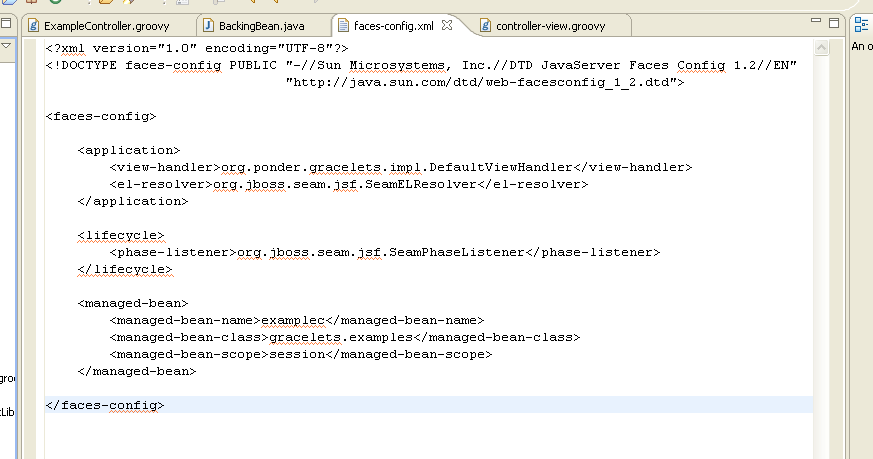 |
In normal JSF we have yet another xml artifact which is necesary in order to
for the backing bean to get resolved in the JSF application EL. Next we define
the java class that will serve as the backing bean.
| JSF Backing Bean/Controller |
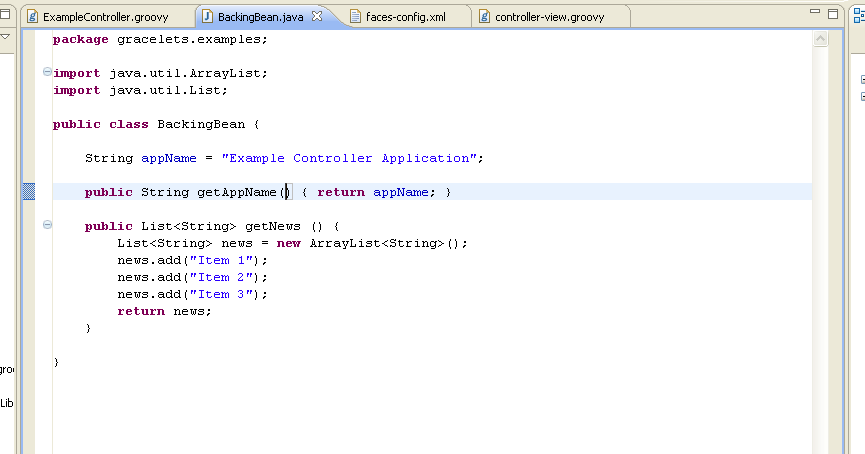 |
Above we define a JSF backing bean which is referenced in the faces-config.xml. An
obvious draw-back is the xml file management for each and every backing bean
and that if we make changes to the backing bean we will then have to redeploy our web application.
Gracelets Controller
| Gracelet Controller Definition |
 |
Here we use a groovy script (reloadable and all) to define our
controller. It is also
automatically detected by the Gracelets system (when put in the WEB-INF/gracelet/controller
directory and it's name must end en Controller.groovy). We can outject and inject simply by
assiging to or referencing non-declared variables and we have the power of groovy, like
not having to declare common getter/setting methods.
Gracelet View using Controller
| Gracelet View |
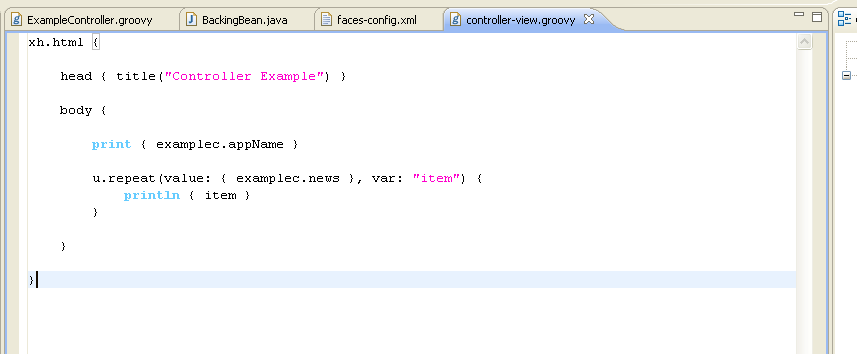 |
Here, whether its a Gracelet Controller or a JSF backing bean or any other type of JSF controller the
view can use them. We also have the power of closures, instead of EL, which gives us
the ability to use any valid java/groovy code inside the closure.
Templating
In JSF/Facelets you would normally do templating by one of two means. You could write a simple view
in the same directory as your root web application and then use Facelets <u:composition template="/path/to/template.xhtml"/>
tag. Or you could create a tag library. The template file is nice, but it would only be usable by your
single application and all the files that use it have to use a somewhat hard coded path. The tag
library option allows you to abstract your templates, but you have to manage an xml file and import
a namespace into each and every view that uses it.
Template View Example
| Facelets Template View |
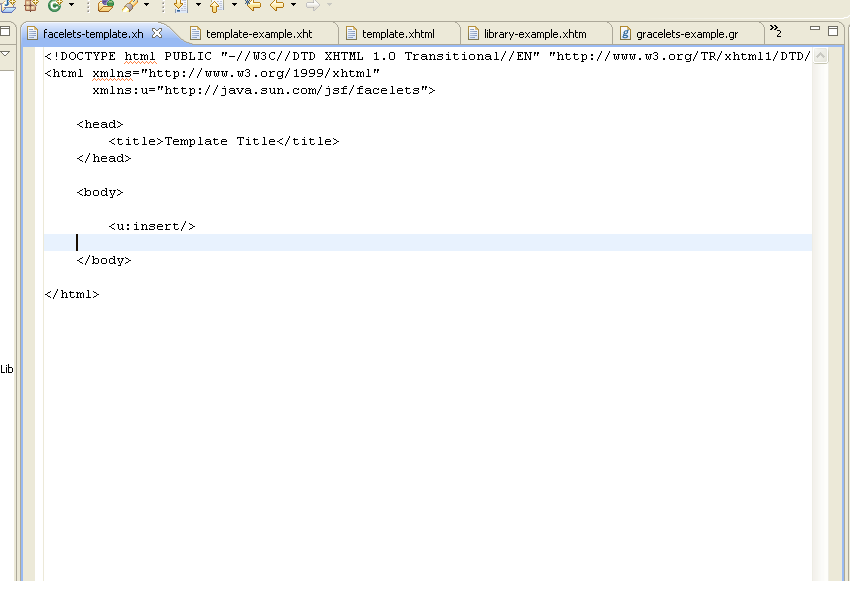 |
Above we define a template in the 'templates' directory in our web application. Below we use
it.
| Facelets Template View Used |
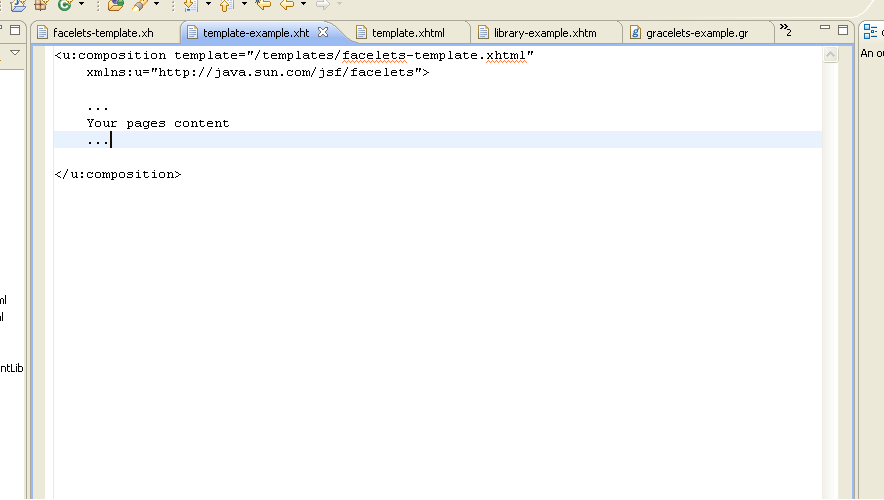 |
Above we use the template. The annoying part is we have to reference it on every page
specifying the template file. Other than that its a good solution.
Facelet Library Example
| Facelets Template View |
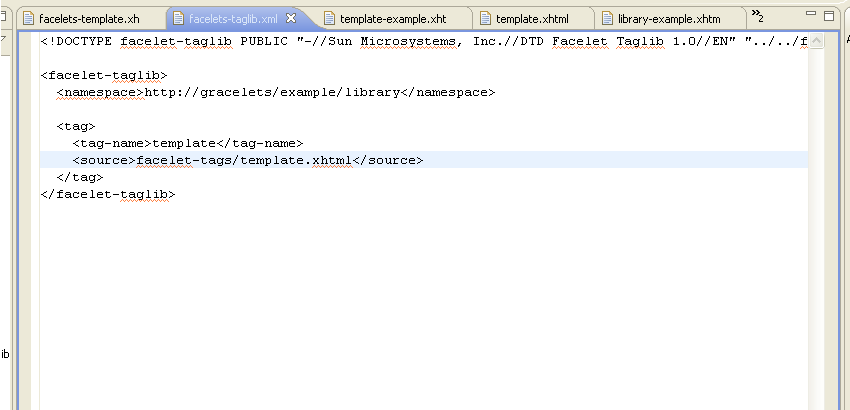 |
Above we define a facelet library in the WEB-INF/classes/META-INF directory in our web application. Below we
define the tag library source file which will be our template.
| Facelets Library Source File |
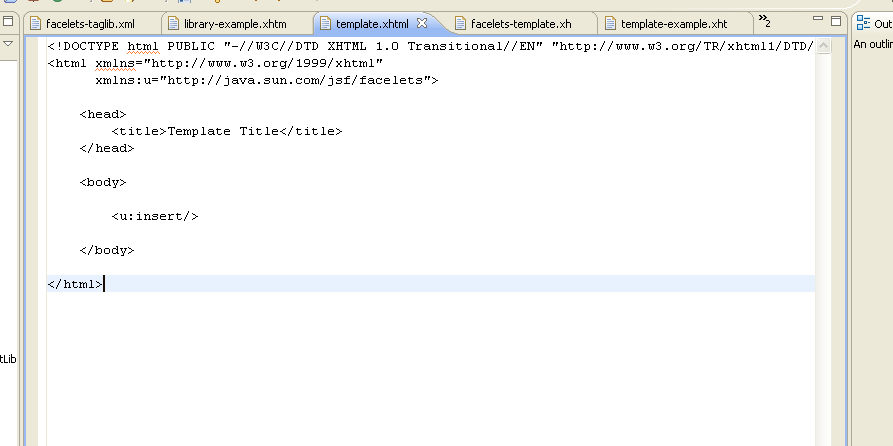 |
Above we define the actual template in the file specified in the above library. Below
we then use this in a actual view.
| Facelets View using Library Template |
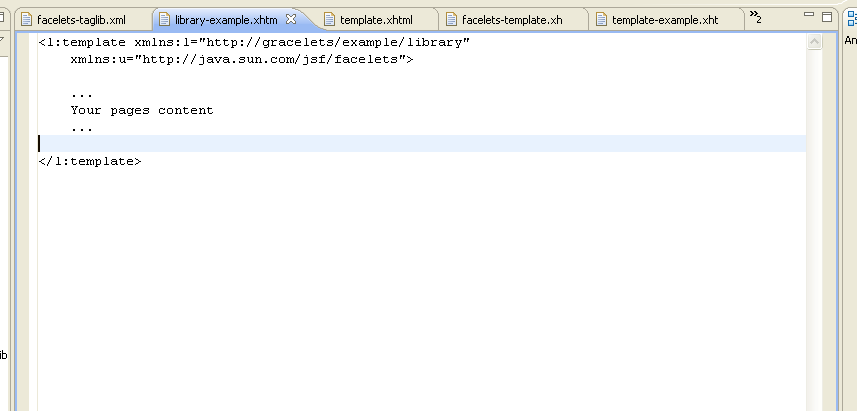 |
Above we use the library template we defined in the above tag library. Its annoying as well
since we have to manage a tag library file and we have to declare the library namespace in
every view.
Simplified Gracelets Example
| Gracelet Component Library |
 |
Above we define a
Gracelet Component Library. This library can contain an array of easy
to define yet powerful components and templates. Here we are simply defining a reusable
template. We also define a namespace and an alias. The alias allows us to use the components
in this library without memorizing a long namespace and having to define it in all of
the views that use it.
| Gracelet View using Gracelet Library |
 |
Above we use the alias to reference the gracelet library we defined. We can put this Gracelet library
in a jar, as a compiled groovy-java class and the like. It is also reloadable, if we modify the library
any views that rely on it will be rebuilt on the next web request after the change. This also allows our
views to not have to declare so much to start using the templates and is less connected to the location
of the template itself. These benefits are in addition to the fact that we are using groovy and all the
power behind it.
Component Development
Any JSF component developer knows that you must manage alot of xml artifacts and that like
controllers, you many times have to redeploy your entire app as you make changes and fix
bugs. The following shows what is involved in defining in the normal JSF/Facelets fashion a
button component that uses the html 'button' tag instead of the 'input' button tag. Then after
it shows how easy it is to define it in a
Gracelet Component Library.
JSF/Facelet Library Example
| JSF Renderer in Java |
 |
Here we create a Renderer class implementation that will render an html "button" tag and handle
event propagation when the button is clicked.
| faces-config.xml Renderer entry |
 |
Here we configure our faces-config.xml file with a 'renderer' entry to define our renderer.
| Facelets tag config |
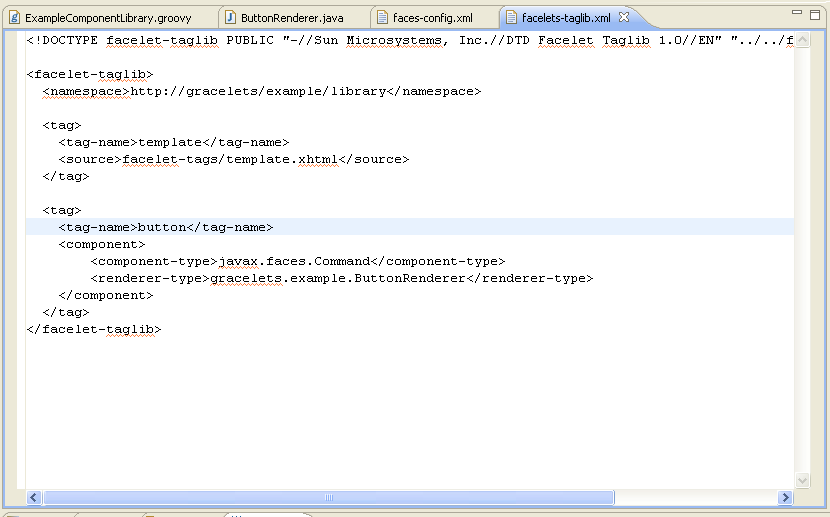 |
Now we do the final part of our renderer setup telling facelets that when the 'button'
tag is used with this library namespace it should create a faces Command component and
use our renderer-id referencing the renderer we created above.
Simplified Gracelets Component Example
| Gracelet Button Component |
 |
Here, in a single file, and in less than half of the Java code needed we define the button
renderer and command component, assign it the button tag name and it is automatically available
with this library. We have the power of groovy and we can change the component and see the
changes implemented without having to redeploy the application.














